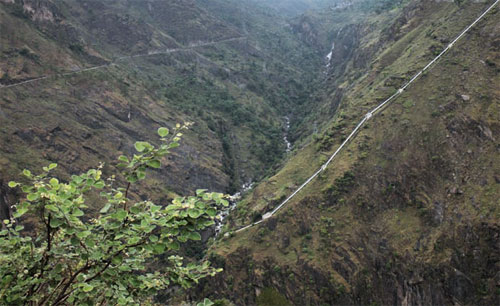AT WHAT COST?
By: ZAEEN DE SOUZA
The recent catastrophic
flashfloods in Uttarakhand
and landslides in Himachal
Pradesh have brought centrestage
the debate on water management
and development in fragile zones.
Having had to deal with the
negative effects of this dam
construction spree – deforestation,
increased siltation, landslides and
increased pollution – project affected
communities have benefitted little
from such ‘development’. Dissenting
voices have been termed ‘antidevelopment’.
 |
| Diverting river
water into a
power-plant |
The total hydel potential of
Himachal Pradesh is a just over
20,000 MW. Many experts however
point out that a majority of the power
plants only generate 20-30 per cent
of their potential power. While the
sheer inefficiency of these power
plants is shocking, the even bigger
problem is the environmental cost of
these projects and the risk involved
in building so many of these projects
in an ecologically fragile zone.
The worst hit by this construction
spree is Kinnaur district in the north
of Himachal, with a total of 18 major
dams, including those already
constructed as well as several
proposed and under construction.
Although touted as environmentally
benign, the construction of these
run-of-the-river dams involves a
huge amount of blasting in the
mountains to create tunnels,
through which river water is diverted
and carried to the turbines in the
power plants located downstream.
The Himalayas, being some of the
youngest mountains in the world,
are naturally fragile, and the
constant and unregulated blasting
weakens the mountainsides,
increases the chances of landslides
and fills the river with silt, further
damaging the already crippled river
and reducing its environmental
carrying capacity.
In Kinnaur, dam builders have
routinely ignored the conditions and
promises they made under environment clearance mechanisms to local
communities under which they have
been permitted to build dams.
According Shanta Kumar Negi, a
local activist, project affected com -
mu nities are promised facilities like
colleges and hospitals by the
builders, so that they don’t oppose
the construction of the dams. The
problem with this is that once the
NOC is given, the builders don’t fulfil
their promises. He says “They’re just
businessmen. They’re here to make
money. That’s it.” There is no one to
ensure that these promises are
fulfilled, and that seems to be
troubling the locals the most. Even if
there is electricity in the district,
where are the schools, hospitals and
colleges that were promised to them?
The other important problem, is that
how can one compensate for the
environmental loss? Once all of the
dams are constructed, the entire
river will be diverted and channelled
underground, and will disappear
completely. R S Negi, a former
bureaucrat, asks “Who will come to
Kinnaur to see a ditch? There’ll be no
river left.”
When it comes to power
generation, one can’t help but notice
that the social and environmental
cost of these dams is too high.
According to R S Negi, Kinnaur only
requires around 7 MW, although the
region has the potential to generate
between 12,000-15,000 MW. The
actual amount of electricity
produced is only about 3,000 MW. Of
this, Himachal retains only 13 per
cent, of which the monetary value of
1 per cent of this electricity is routed
to the Local Area Development Fund
(LADF). This fund is used to develop
the project affected area by building
schools, colleges and hospitals, etc.
The remaining 87 per cent is sold by
the developer to the national grid.
Despite these somewhat generous terms of energy trade, said
Shanta Kumar, some of the towns near the north west of Kinnaur, still
don’t have constant electricity. He
points out that that there are people
still waiting for the monetary
compensation, as well as the
facilities they were promised. As of
2011, the power companies still owe
the Himachal Government Rs.264 cr,
as part of the LADF.
Deforestation remains a major
concern. A 2011 study on five project
affected villages in Kinnaur by
Renuka Thapliyal and Manoj Jreat,
show that 35,046 trees were
damaged and felled, during the
construction of dams in the district.
Amongst these felled and damaged
trees are endangered Chilgoza pine,
prized by local communities for their
pine nuts. A total of 7,89479 hectares
of forest land was ‘diverted’ to enable
the construction of these dams.
This is the cost that the people of
Kinnaur are paying for their
electricity. They give up their land,
their forests and their water, and all
they get in return, are false promises
and in many cases, electricity
problems. Is this “development”
really worth it?
| |
| I N T E R V I E W |
 |
Shanta Kumar Negi
an engineer from
Punjab University and
an anti-dam activist in
Himachal Pradesh
interacted with
Nishant Saxena and
B Harikrishnan |
| |
Q 1. What do think about the
instalment of hydro power projects
in your state?
I understand the concern of the
government towards the increase in the
energy requirement but I think we
should also focus on the cost at which
we are installing these dams. The
negative effect of hydro projects to
environment, loss of people's rights and
livelihoods, danger to national security
and gross violation of tribal, environment and forest laws cannot be
compensated. Moreover energy requirement is a never ending greed; I don't
think we should run after it blindly.
Q 2. What are the problems people face due to these projects?
What
kind of rehabilitation and compensation is missing according to you,
because we are told that proper
compensation is provided, in fact
one hospital was also built which
functions quite well?
There is not a single problem, from
resettlement and rehabilitation to
employment and damage to the
environment. There are a lot of
problems. We go to the govt. and the
concerned company to ask for proper
compensation but we don't get
anything. They don't even reply properly.
Yes they speak very confidently about
the hospital. Go to the site and you will
know the reality. The hospital worked
quite well till the construction was going
on; as the construction got completed
the hospital's condition became worse
than any government hospital.
Q 3. How are the villagers/ locali tes
involved in the decision of building a
dam?
People were totally unaware earlier. They
have been fooled all the time, but
gradually things started changing. With
the command of NOC coming to the
gram Sabah a lot of flip in power play
has taken place. No project can start till
the time the gram Sabah gives No
Objection Certificate.
Q 4. What do you have to say
about the rumours that suggest that
Gram Sabhas accepts undue favours
for handing out NOCs?
They are only rumours. These people
have been putting such accusations but
there hasn't been any such case. It is all
a game of NOCs now. They have tried
to bribe people but it didn't work out for
them. People in Kinnaur just don't want
these dams anymore, what they only
want is to preserve their resources. We
always give them Total Objection
Certificate (TOC).
Q 5. According to official sources,
skilled labour cannot be provided
to the locals because they are
not technically equipped. Most of
them have just completed their
intermediate education. What do
you have to say about it?
He is right to say that, but the question
that arises is, in an isolated district like
Kinnaur how do you think these poor
people will get the required technical
knowledge. I think if the government
is really keen to employ the locals, they
should conduct a 6 month or a years' technical training programme.
Q 6. Looking at the present
situation, what do you think about
the future of Kinnaur?
The future is unpredictable but if we
keep in mind today's pace of
'development' then I don't see any
bright future. Although people of
Kinnaur are more aware now and they
will surely find a way out of this
mishappening but I
think even the authority should also
show real concern towards the
deteriorating environment. Such
development is unsustainable. |
| |
